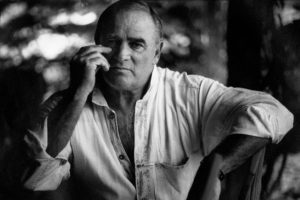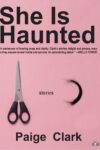“It’s being said that short stories are making a comeback,” British author Graham Swift wrote in The Guardian in July 2015 on the occasion of having published the collection England and Other Stories after a 30-year hiatus from the form. “As human beings we’re all short-story enthusiasts. It’s the novel that’s the oddity,” said the author of Last Orders and Waterland.
Short stories as a literary form with popular and commercial appeal are always either dying or making a comeback, it seems.
For three decades, amid the roller-coaster ride for short fiction, one shining bastion of unwavering devotion has been a little known foundation in the rural, pretty, affluent town of Washington, Conn., recently “famous” as the place that inspired The Gilmore Girls.
The Dungannon Foundation was the creation of commercial real estate mogul and collector of art Michael Moorhead Rea, an Irishman by heritage who loved short stories so much he created The Rea Award for the Short Story, an annual award honoring a writer of short stories with affirmation and $30,000.
This year’s award, to be announced in late April or early May, will mark the 30th anniversary. Michael Rea died in 1996, but the foundation has been sustained, and the award lovingly administered, by his widow, the photographer Elizabeth Richebourg Rea.
I asked Elizabeth Rea to take a look back as she prepares to celebrate a literary milestone for a form whose enduring value has been well articulated by so many writers, including Rea Award winner Andre Dubus, author of Adultery & Other Choices, whose work has been compared to Hemingway’s and Chekhov’s:
“I love short stories because I believe they are the way we live. They are what our friends tell us, in their pain and joy, their passion and rage, their yearning and their cry against injustice.”
Doug Clement: Where to start? You’re the last noble sentry, the keeper of faith for connoisseurs devoted to a literary form that may be the most challenging for writers and most rewarding for readers—but one whose public profile has become almost nonexistent. Against that backdrop, and when even media has disavowed coverage of The Rea Award, what sustains you three decades on?
Elizabeth Richebourg Rea: What has sustained me to continue this most prestigious award is that I am honoring Michael’s legacy; he would be so proud. He founded The Rea Award for the Short Story out of a passionate love for the short story form. I believe the public profile of the story is stronger today and I think Michael would be encouraged by the output of story writing. There are more stories being written now than ever but with the advent of the Internet and the economic pressures of book publishing, finding and sifting through to discover the best in story writing has become more of a challenge. The continued pursuit to acknowledge and celebrate short story writers was Michael’s goal.
The mainstream media’s desertion of providing any substantial coverage is a bit shocking; this is a $30,000 award and the winners are among the best writers in the world. What comes to mind when you juxtapose the current situation with Michael’s foundational statement: “The basic thrust of the award is to foster a literary cause, to ennoble the form, to give it prestige.”?
The goal remains the same. Michael founded the award in 1986 to highlight the very best short stories, and to celebrate the writers who devote themselves to the art of the short story. Fiction writers hold The Rea Award in high regard despite any lessening of press attention. Fortunately, the short story form is today firmly established and is as respected as the novel. The digital age has prompted more writers who now have the advanced medium of the computer to further the literary cause. The fast pace with use of the Internet has allowed the word of the press to reach news sources in an instant across the globe. The Rea Award winner is announced over the wire services with the push of a button so the word does reach far and wide. Of course I would love to see more in-depth coverage. Book sections in newspapers seem to have gone by the wayside with more emphasis on entertainment news. Also, there are more literary awards today, including ones that highlight the short story, further evidence of Michael’s goal to encourage short story writing. Michael’s dream is coming true: that of “fostering the literary cause, ennobling the form, giving it prestige.” The Rea Award established 30 years ago is one of the first literary awards given solely for the short story; it is well regarded in literary circles and honors the finest practitioners of short story writing.
There was such hope back then, in the mid-1980s. In 1985, a year before Michael established the award, The New York Times had this to say in a story entitled “A New Life for the Short Story”: “The conventional wisdom about the fate of short-story collections is that they do not sell – except now and then. But judged by the new book-publishing lists – and the growing number of literary magazines that offer outlets for big names as well as unknowns – the conventional wisdom may no longer hold up.” Do you remember a moment when things began to change, when you felt the flame flicker?
I am not sure there was a particular moment. But over the last several years there seems to be a movement toward more exposure for the story. Alice Munro has made a career of writing nothing but short stories. Her collections often make The New York Times Best Seller lists. T.C. Boyle continues to write compelling short stories. To see a collection like George Saunder’s The Tenth of December receive not only critical acclaim but to make the Best Seller list is outstanding. All of this attention to the story tells me that the short story is alive and well.
What do you think is the greatest strength of The Rea Award? What sets it apart from the many other literary awards now available?
The greatest strength is our jurors and how Michael set up the administration of the award in 1986. He kept the guidelines simple; the annual award cannot be applied for; each year three jurors are appointed and asked to nominate two writers of their peers. The nominees are not announced and their names are kept confidential. The jurors are given ample time to read the writings of the six nominees; then a date is set for deliberating to decide the winner. Michael made it a point to stay out of the decision-making process so he would not influence the jurors’ decision and I have maintained that tradition. One of the really great pleasures of the process is telephoning the winner with the jurors on the day of the deliberation. For the winner, it’s like a bolt from the blue.
Is there a special/different feeling in this 30th anniversary year; a memory, particular type of satisfaction, a reconnection with a favorite writer?
There are countless special moments I will hold in memory forever, reminders of the beginning days when Michael founded the award until now after 30 years. I have met jurors, nominees and winners who respect and honor the award and who have helped me immeasurably going forward and are also good friends. Here are just a few very special recollections.
I remember the very first day the first jury met to decide the winner of The Rea Award: Michael telephoned Cynthia Ozick to tell her she had just won the first Rea Award for the Short Story. He spoke about his love of the story as an art form and about his passion and commitment to encourage the writing of short fiction. She expressed such utmost delight in the honor of receiving his award that it touched him deeply.
The phone call to the winner each year was exhilarating for Michael, and I have kept this tradition. Michael’s greatest thrill was talking with or meeting the writers, the jurors and the winner. Over the years I’ve developed special bonds with many of the writers honored by The Rea Award, many of whom knew Michael. The 1997 Rea Award jury following Michael’s death in 1996 was compromised of three winners: Cynthia Ozick (1986) Tobias Wolff (1989) and Andre Dubus (1996). They made the trip to New York to honor Michael. Travel was difficult for Andre, who was wheelchair bound, but he wanted to make the trip if I would make it possible to access and navigate his way down from Andover, MA. Gina Berriault was elected the 1997 Winner. The deliberation meeting and lunch were memorable. Our tradition was to celebrate the winner over lunch at Sign of the Dove. The restaurant allowed us to open a side door for Andre as a special favor for access to our table. In calling Berriault to tell her of her win, she offered beautiful words of sympathy for my loss and made reference to her story, “Women in their Beds,” as a comfort. That year Cynthia Ozick helped me re-write the press release word for word in dedication to Michael.
As the award matured into its third decade, it became more and more of a challenge for me to seek and impanel the jury on my own. Richard Ford offered his expertise and direction and urged me onward. He has played a significant role and has been a source of ever-present guidance. For several years, Richard was at the helm forming the jury and was also a generous resource for nominees to win the award. He has been my guiding light when I thought sources were exhausted; he has bolstered my resolve to continue the award. His advice has been invaluable as I move forward during these years without Michael.
Also, there is a book I will treasure forever and that is Michael’s anthology The American Story. Published by Ecco Press in 1993, Michael asked six jurors and winners of The Rea to select their favorite stories by three writers from a list of winners and nominees of award. The book has an introduction by Charles McGrath and a moving tribute by William Styron. Michael had plans to distribute his book to libraries and universities across the country for purposes of study. Of special meaning to me is The Rea Award’s 1990 Winner Joyce Carol Oates’ use of the book in her English writing class at Princeton University. I endeavor to carry out Michael’s wish, distributing The American Story to libraries and universities across the country.
Let’s remind people about Michael’s devotion to the short story and how the award began. His success came in real estate but he loved reading and art. How did that all fit together?
Michael would compare the experience of reading a short story in one sitting to standing in front of a great painting and taking in the beauty all at once. He loved holding the book as an art object and amassed an impressive collection of first editions by many of the classic American short story writers, such as Poe, Hawthorne, James and Hemingway. This collection still resides in its Biedermier glass cupboard, each book placed just as Michael had them arranged. He read from these rare books as a kind of ritual, becoming more and more passionate about the short story as an art form; he tried his hand at writing and understood how incredibly difficult the short form was to master. But he also understood the economics of writing. Many writers would tell him, “I love short stories, but they don’t sell. My publisher says that if I want to become a successful writer I need to write novels.”
It was also at this time that Michael partnered with a rare book dealer to learn the art of publishing. Under Michael’s publication name, Sweetwater Editions, he published two limited edition leather bound books, one on the subject of New England gravestone rubbings and the other a reprint of Isaac Bashevis Singer’s Satan in Goray with a new introduction by Singer and original drawings by Ira Moskowitz. This love of the book as object combined with his passion for the story form and a desire to help keep that flame alive, is what inspired him to conceive The Rea Award.
Michael’s heritage was Irish, and the administrative entity for The Rea Award, the Dungannon Foundation, is named for his paternal hometown in County Tyrone, Northern Ireland. Did it all begin for him with Irish short stories?
Yes. He kept the Collected Stories of William Trevor nearby at all times for reference and for re-reading a favorite story. He was inspired by Irish short story writing, renowned storytellers. His award, however, focuses on the American short story; his desire was to encourage the writing of short stories in America. He did have the opportunity to visit his ancestral hometown, Dungannon, in Northern Ireland near Belfast. A very special journey for him, he connected with two elderly aunts, his only living Irish relatives. Wishing to honor his Irish heritage, he decided to establish the Dungannon Foundation as sponsor of his literary endeavors.
Who are your favorite authors of short stories, novels or nonfiction? What works do you cherish, and what’s on your nightstand now?
On my night table right now are stories by Andrea Barrett, who won the 2015 Rea Award and T.C. Boyle who won in 2014; also the newly published book of stories by Joy Williams The Visiting Privilege and John Edgar Wideman’s God’s Gym. It is impossible to name one favorite story considering 30 years of jurors, nominees and winners’ stories. Michael and I both were deeply moved by Cynthia Ozick’s “The Shawl”. I think the reason is two-fold: it was our first favorite story together and she was the first winner of The Rea Award in 1986. I have many other favorites: Tobias Wolff’s This Boy’s Life; Andre Dubus’ “Killings“ (adapted for the screen, In the Bedroom); Ann Beattie’s “A Vintage Thunderbird,” and Richard Ford’s story collection, Rock Springs, to name just a few.
Do you have a personal favorite among the winners of The Rea Award? (Mine are James Salter and Paul Bowles, which is less a generational or gender statement than a reflection of how poorly read I seem to be in a genre I cherish; time’s arrow and life’s responsibilities piercing inspiration and aspiration).
It’s difficult to point out a personal favorite. I am always kind of awed by the writers the jurors choose. Sometimes I am particularly pleased when a writer who has been nominated several times wins the award. That tells me the process is right and that I need to continue.
In 2006, a year marking the 20th Anniversary of the award, I asked you what attracted you to the form and you said, “It’s the conciseness of the words; the fewer the words, the more powerful, to me, is a short story.” I assume that assessment holds true today?
Probably more so today than even five years ago. The short story demands precision and discipline to find exactly the right words, with no waste. Michael loved Hemingway’s stripped-down prose for exactly those reasons. The award has continued honoring that style with winners such as Amy Hempel, Lorrie Moore and Mary Robison. The short short story is a most compelling achievement in my view. A brilliant example is Joyce Carol Oates’ “Slow,” which she read from the Symphony Space stage on the night of The Rea Award’s 20th Anniversary.
Given the brevity of stories, their endings have critical importance. Inspired by Michael’s heritage, when I think of perfect endings James Joyce’s “The Dead” always comes to mind. It’s a worthy introduction to asking about Michael’s favorite endings, or yours?
Michael spoke of the haunting endings of such stories as Joyce Carol Oates’ “Heat,” Andre Dubus’ “Killings,” Tobias Wolff’s “Our Story Begins,” and Tim O’Brien’s The Things They Carried. Those stories held special meaning for Michael. Two other favorite stories are Paul Bowles’ “A Distant Episode,” and Robert Coover’s “You Must Remember This”. (The collection A Night at the Movies includes the story “You Must Remember This,” a piece from Casablanca that features an explicitly erotic description of what Rick and Ilsa did when the camera was not on them.) These stories had that extraordinary power to transform our thinking about the world. Michael would enjoy reading Coover’s story over and over again, and laughed aloud at each reading. As my own private tribute, I invited Robert Coover to read passages from “You Must Remember This,” on the occasion of Michael’s memorial held in the Rotunda of the Guggenheim Museum in New York. Michael, a Trustee of the Guggenheim, would have been proud that this story was permitted to be read out loud in such a magnificent venue.
It’s often asked if there’s a formal ceremony when the winner of The Rea Award is announced.
Michael did not want any fanfare surrounding his award; he personally wanted to keep a low profile. It was not his desire to be the center of attention or to become personally known. He wanted the award to continue and to focus attention on the story form. In the beginning of the award, we would sometimes have a small dinner party for the winner at our apartment in New York. Michael delighted in meeting the winner, the jurors, editors and publishers. He loved the world of literature and was in his element when he could talk with the writers of the work he had become so passionate about over the years.
There was one very special public evening devoted to The Rea Award for the Short Story. The 20th Anniversary Celebration, produced by the Dungannon Foundation, was held at Symphony Space in 2006. Anne Beattie, the 2005 Rea Award winner, was instrumental in helping me organize this most special evening. I invited ten Rea Award Winners to say a few words and/or to read from their stories. All ten writers made the trip to New York with the desire to honor Michael M. Rea and The Rea Award. The program was a magnificent and touching tribute. Cynthia Ozick’s “The Shawl” was read by Actor Lois Smith; Cynthia followed the reading with words of gratitude for Michael and his award. Winners Ann Beattie, Deborah Eisenberg, Richard Ford, Joyce Carol Oates, Grace Paley, Tobias Wolff, John Edgar Wideman, and Joy Williams each read from their own stories and thanked Michael. John Updike’s “The Orphaned Swimming Pool” was read by Actor Campbell Scott, and Updike closed the evening with eloquent remarks about the short story. The evening was hosted by Symphony Space’s Artistic Director Isaiah Sheffer and Producer Kathy Minton.
What does the future hold for The Rea Award and is there anything you would like to add about this most special award and its founder, Michael M. Rea?
My husband did not want me to be burdened by the task of running the award. But fortunately I was present with Michael each year from the beginning. There was not one moment when I had thoughts of not continuing the running of the award; I wanted to do it for Michael and I had the benefit of experiencing the process with him. I had the help of past jurors and winners who would suggest writers for the jury. I have met wonderful friends in the literary world; the journey has been rewarding beyond measure. I will run the award for as long as possible, searching for the right home for the Dungannon Foundation to sponsor Michael’s award for its future years. The foundation also supports the annual Rea Visiting Writers and Lecturers programs at the University of Virginia as well as Selected Shorts: A Celebration of the Short Story at Symphony Space in New York City and broadcast on National Public Radio.
On a personal note, each year in late spring, the time of giving the Rea Award, I sense Michael’s presence especially at the moment the winner is decided; the phone call is emotional for me and for the winner. It has been 30 years, yet the award generates the same excitement. Michael wrote the criteria for winning his award on a slip of paper that he kept in his wallet. Those words as quoted below were of singular importance and represent Michael’s true meaning of the award. The Rea Award honors a living American writer “who has made a significant contribution to the discipline of the short story as an art form.” He carefully scripted these words as if to carve them in stone. Michael’s legacy continues; he has achieved his endeavor to encourage the writing of the short story.
Douglas P. Clement is an award-winning newspaper and magazine writer and editor whose recent work includes regional arts & culture coverage for The New York Times. He’s also the principal of Boardwalk Media + Communications, and his collection of short stories remains a work-in-progress.
This post may contain affiliate links.









